#brothers grimm fairytales
Explore tagged Tumblr posts
Text
Some scholarly notes about the Grimm fairytales (1)
Recently in France (well... for the last two dozen years), the publishing house José Corti has been specializing itself in scientific fairytales collections. While for the study of literary fairytales one would go towards Honoré Champion, when it comes to folktales and fairytales it is José Corti one must check. In their "Merveilleux" collection they have been publishing for the very first time in France or republishing out-of-prints collections of various European fairytales (from Denmark, Spain, Romania, and more) - with a few classics of the "literary" fairytales that marked deeply the evolution of the genre (such as Straparola's Facetious Nights or Ludwig Bechstein's fairytales).
All of that to say, José Corti has in 2009 published the most recent scientific (but for an all-public) edition of the brothers Grimm fairytales. The full collection of their fairytales, translated accurately in French, with annotations about their type/classification, their evolution throughout editions and their predecessors. I can't share all of these annotations with you, of course, but I can share a handful of them, about the most famous stories of the Grimm. They all come from the same person who translated the story in this edition: Natacha Rimasson-Fertin. (Of course my notes might be incomplete but hey, you'll have to buy the books to see the whole thing :p Or check them out at your local library)

The devil with three golden hairs (Der Teufel mit den dre goldenen Haaren)
This story is at the crossroa between the Aa-Th 461 "Three hair from the devil's beard" ; the AT 460B "The quest for fortune" and the AT 93à "Urie's letter/The prophecy".
In the 1812 edition, there were two different versions of this tale. Story number 29 "The story of the devil with three golden hair", told by Amalia Hassenpflug, and number 75, "The phenix", told by her sister Mary. In the second version the devil was replaced by a phoenix, and the hero had to get three feathers. In the 1819 edition the two stories disappeared and were replaced by the version we know today, told by Dorothea Viehmann. Another version that the Grimms had collected in 1812 had a princess falling in love with the woodsman that cuts a tree below her window.
The final episode, where the hero asks three questions to the devil through the old woman, echoes the Pentamerone's "The Seven Doves". Other versions of this story include Asbjörnsen-Moe's "The wealthy Peter Krämer", and Afanassiev's "Marco the Wealthy and Vassili the Unfortunate". The story of the brothers Grimm gathers several references to the Bible: the child throw in the water echoes Moses' abandonment, the letter meant to kill the hero is similar to the one David uses to kill Urie, finally the hair as holders of a being's wisdom and strength is linked to the legend of Samson and Dalila. But many other elements of the story evoke older faiths. The idea of a body of water as the frontier with the Otherworld can be found in the Classical Antiquity with the Greek Charon, and is found in other stories of the volume, such as "Frau Holle" and "The Iron Stove" - it as believed that water formed an obstacle spirits could not cross. The hero's mission recalls a tale of Saxo Grammaticus where Thorkill enters Utgard (the realm of supernatural beings) to steal a hair from the beard of Utgard-loki. The brothers Grimm had noted that the belief in the exceptional fate of a child born with a "hood" was also found in Iceland, where the "caul", called Glückshaut (skin of luck) was the home of a genie that would follow the child all of his life. And indeed, modern research has proven that the name given to this caul, the "fyljia" was also the name of a spiritual double, a tutlar spirit tied to a person or a family. This is why the tradition was to preserve and hide this "pileus naturalis" - in Belgium, it was called a "hem" and its color allowed for divination rituals about the child's future.
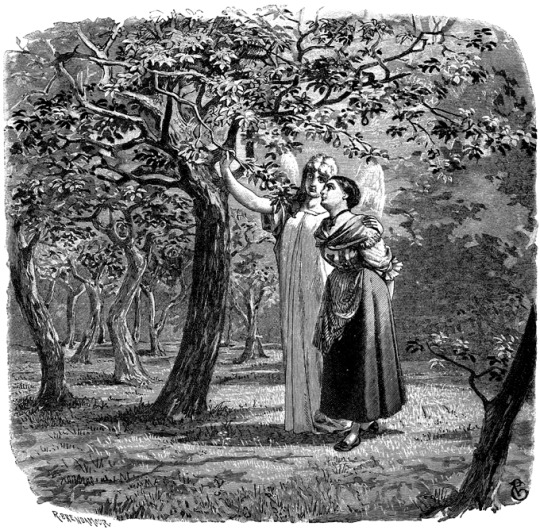
The girl without hands (Das Mädchen ohne Hände)
This fairytale is actually a cross between the AT type 706 "The maiden without hands" and the AT 930 "Urie's letter/The prophecy". The story was created by the brothers mixing two versions from Hesse, one told by Mary Hassenpflug, the other by Dorothea Viehmann. The second version lacks this story's introduction and begins with a father trying to marry his own daughter - when she refuses, he cuts off her hands and breasts, and chases her out of his house. It then follows the story. Meanwhile, the first version differs when the heroine is with her child in the forest: an old man tells her to hug three time a tree with her arms, which makes her hands grow again. He also tells her to only open the door of her house to one who will ask to enter "for the love of God" three times in a row - the king will be forced to do this before entering.
Outside of these two main versions, the brothers Grimm collected three additional ones. In the first, the angel that guides the girl is replaced by a small light that descends from the sky ; and the hands of the girl grow back when she plunges her arms in a stream after seeing a blind mouse enter its water to regain its sight. In the second version, a man is upset at his little girl praying for him day and night, but since she refuses to stop despite his demands, he cuts off her tongue. But she prays in thought and makes the sign of the cross, so he cuts off her right hand, then her arm all the way to the elbow, before banishing her. She is saved by a hunter that hides her in his master's domain and feeds her in secret with his master's dogs. When the master discovers this, he decides to raise the girl as his own child. One day she gives money to a poor man, who tells her she will regain her arm and tongue if she goes to drink of a certain stream, and he gives her a magical staff to protect her. When she returns at the lord's house, he marries her. The third version is about a queen banished by her husband with her two children, and is identical to the legend of saint Helen.
Other international versions of the tale include Zingerle's "The pretty daughter of the innkeeper", Basile's "Penta the one-armed girl" and Afanassiev's "The young girl without hands". There are some versions where it is a man that is mutlated, such as Afanassiev's "The brave without legs and the blind brave". The roots of this story date back to the end of the 12th century, and are located in southern England - this tale was the subject of numerous literary adaptations, the most famous being the verse romance of the 13th century "The Beautiful Helen of Constantinople".
The motif of the child sold to the devil is recurring among the Grimm fairytales - even though the character of the devil can be replaced by another supernatural being, such as in "Rapunzel" or "The Nixie of the Mill-Pond". The idea of offering the first thing one sees upon returning home is as old as the Ancient Testament (Judges). This story bears the signs of a heavy Christianiation, and was clearly inspired by the legend of Saint Genevieve of Brabant, falsefely accused of being unfaithful and condemned to death with her newborn child. The executioners take pity on her and she lives alone in the woods for seven years. As with other tales from the Grimm collection, this story mixes the Christian fantasy (the hands that regrow are treated as a Christian miracle) with pagan fantasy (there are several elements of folk-magic, such as the circle the girl draws around her to be protected from the devil, or the accusations of the queen giving birth to a changeling - a changeling also appears in the third story of "The Elves", KHM 39).

The Robber Bridegroom (Der Räuberbräutigam)
This story belongs to the fairytale type Aa-Th 955, named after it: "The robber bridegroom".
The tale was told to Jacob Grimm by Mary Hassenpflug, and was present as early as the 1810 manuscript. However this first version, that the brothers deemed "incomplete" was replaced from the 1812 edition onward by a new version which mixed two versions from Lower-Hesse. The brothers noted the existence of another version where the robber indicated the road to his house to a princess, by tying ribbons around the trees.
Ludwig Bechstein took inspiration from the brothers Grimm's tale to create his own "The Robber Bridegroom". This fairytale, like "Fichter's Bird", belongs to the "Bluebeard cycle" (several tales that the brothers removed from their first edition also belonged to this cycle).
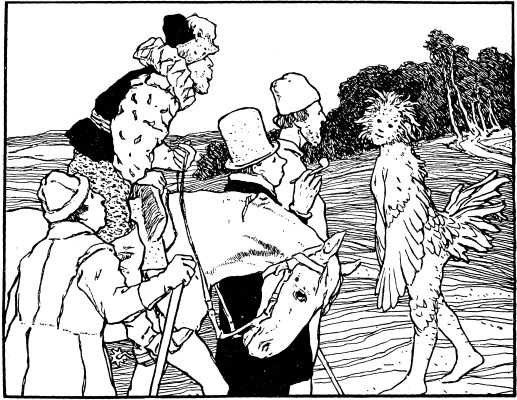
Fitcher's Bird (Fitchers Vogel)
This tale is a variation of the Aa-Th 311 "The heroine rescues herself and her sisters", usually classified under the "Bluebeard" category.
The final text of the Grimms is actually a mix of two different versions of the same story that was told to the brothers by both Friedrike Mannel and Dortchen Wild. The Grimms noted the existence of a version from Hanovre which goes as follow: a poor woodcutter asks his daughter to bring him his meal in the forest, and to show them the way he places peas on the floor. However dwarves notice this, and change the emplacement of the pea so that their path leads to their grotto. The older girl follows the peas, and become the dwarves' slave. Then we have the Bluebeard "forbidden room" motif, and the story goes as the "Fitcher's Bird" goes, as the dwarves lure the two other sisters to their cave. The last sister sticks the feathers on her body by rolling herself in blood (presumably the blood of the dwarves' victims), and there is no resurrection of the sisters. Everybody that meets her on the way call her "geputzter Vogel". The dwarves hunt the girl down and almost catch her just as she reaches her father's house - she is so fast in closing the door that it cuts a piece of her heel. The Grimms also knew of a Dutch version of the story, translated in German, and that was identical to one of their first-editions tales, "The Murder-Castle".
The translation of the name of the "bird" always caused many problems, due to the difficulty of understanding the expression. The brothers Grimm themselves explained the name of the bird by the Icelandic "Fitfuglar", meaning "birds that swim" - as such, the girl would be called "Fitchers-Vogel" because she looks like a swan". However, other people do not agree with this etymology, some linking Fitcher with "Fitze", the thread. Rimasson-Fertin highlights that the expression "Fitchers Fitze", outside of a simple sonority game, might be two variations of the male name Fritz (the diminutive of Friedrich) - other usual diminutives were Fitze, Fitz and Fiete. The brothers Grimm noted that the motif of the blood that cannot be erased was much older than Perrault's Bluebeard - it could be found as early as the "Gesta Romanorum", where a mother who had murdered her child couldn't erase three blood-drops from her hand, forcing her to wear a glove. This story must be compared to the KHM 40, "The Robber Bridegroom".
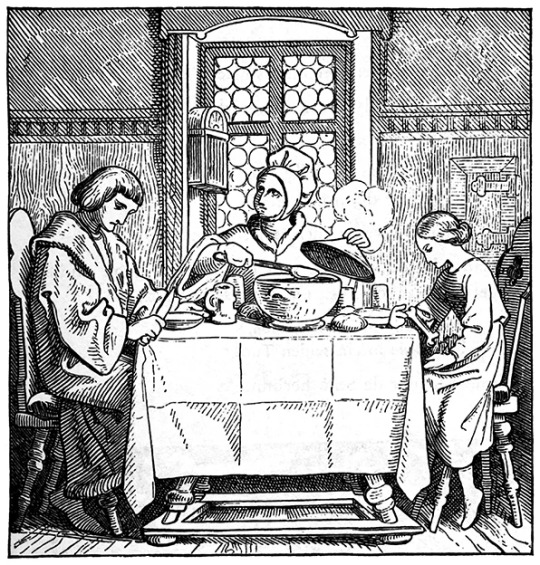
The Juniper Tree (Von dem Machandelboom)
It is the AaTh 720 "My mother killed me, my father ate me".
Just like the tale of "The Fisherman and his wife", this story was written by the painter P. O. Runge, and the brothers Grimm used it as a model for how they should present their own fairy tales. In fact, we can note sentences almost identical between the two tales.
The brothers noted a variation of the story where the stepmother places her daughter near the pot where her brother cooks, and she forbids her from looking inside. But since the pot boils too much, the girl lifts the lid - then her brother's hand reaches out to her from the cauldron. There is yet another version noted by the Grimm where there are three children, not two, and the stepmother sends them pick up strawberries in the wood, promising an apple to whoever comes back first.
The cruelty of this fairytale earned the brothers a serious criticism from Achim von Arnim - who only tolerated such violence because it echoed the one present in Goethe's Faust. The description "red as blood, white as snow" of course echoes the tale of "Snow-White". The brothers Grimm mentionned in their notes that the juniper tree was a plant believed to have the power to bring back youth - and Rölleke noted that the juniper-tree's red berries were used in folk-magic. It seems to be a very ancient tale due to several very old motifs such as the soul returning in the shape of a bird, a resurrection out of bones, and cannibalism. This tale must be compared to "Brother Lustig", "The Singing Bone" and, of course, "The Fisherman and his wife".

Briar Rose (Dornröschen)
Of course, it is the AaTh 410 "Sleeping Beauty".
This fairytale was present as early as the 1810 manuscript, written by Jacob Grimm from a tale told by Marie Hassenpflug. Research has proven that this story is derived from Charles Perrault's own Sleeping Beauty. We also find back in the German story a motif coming from another famous French literary fairytale, madame d'Aulnoy's "The Hind in the Woods/The Doe in the Woods" (also known as the White Doe). In this story a Crayfish/Lobster fairy announces to the queen she will have a child, and later the same fairy curses the princess as she is born - and what a coincidence! In the first edition of "Briar Rose", the animal that announces the princess' birth is not a frog... but a crayfish. Proving that there is a direct link. As for the name of the princess n German, "Dornröschen", "small briar rose", it actually first appeared in the German translation of a 1730 fairytale by Anthony Hamilton (an Irish man who however spoke and wrote French), "Fleur d'épine" (Thorn flower/Briar flower) - it had been translated in 1790. Bolte and Polivka have also noted a comedy by Gryphius from 1660 whch was named "Die geliebte Dornrose", "The beloved briar rose".
In their notes about the fairytale, the Grimm brothers explicitely compare Briar Rose to the legend of Brunhild asleep behind a wall of fire, cursed into a magical slumber by Odin's "sleep-thorn" and woken up by Sigurd, the only one able to cross the wall of flames. The brothers Grimm were also aware of Basile's version of the story, "Thalia, Sun and Moon", which they compared to their own Briar Rose in their notes. The brothers were very fascinated by the consistant naming of the princess' children from Perrault (Dawn, Day) to Basile (Sun, Moon) and compared it to the occurences of "Day, Sun and Moon" as names within the Eddas. However we know that Perrault was heavily inspired by Basile's story when writing his own Sleeping Beauty, and only modified some parts so as to erase the more shocking and "unpleasant" parts (such as the married prince having sex with the sleeping girl). Of course, this story is also to be compared with the 14th century medieval tale of the Roman de Perceforest.
The wise women that appear in this story are the Germanic equivalent of the fairies. In fact, we know that the brothers Grimm carefully avoided (or erased) any mention of "Fee" (the German word for the English "fairy" and French "fée") from their tales, so as to better differentiate them from the French "fairy tales", "contes de fées". By turning the fairies into wise women making predictions at the child's birth, the Grimms notably opened an entire set of symbolism and interpretations linking them to the mythological figures of the Norns, Parcae and Moirai.
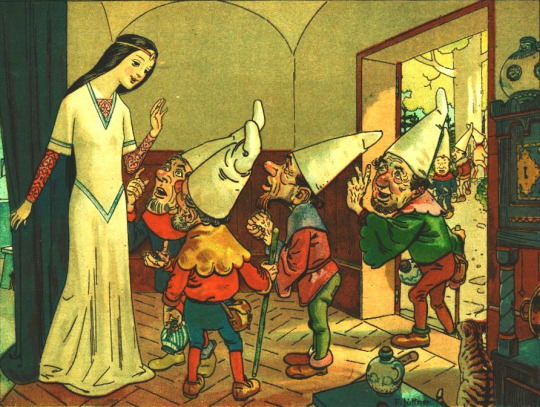
Snow White (Schneewittchen)
Of course, it is the AaTh 709 "Snow-White".
The full editing history of this tale was only "recently" recreated (the book was published in 2009, it was recent back then) in its entirety. We know that it begins in 1808 with a version collected by Ferdinand Grimm, brother of Jacob and Wilhelm, called "Schneeweibchen". It seems Ferdinand might have invented the story on his own. Wilhelm and Jacob then slowly modified it, by adding details from other collected versions, before publishing it in their first edition in 1810 (they did note at the time that it was a Lower-Germany story, and that in Upper-Germany the tale did exist but with the deformed name of "Schliwitchen". When the Grimms did their second edition, the main change they performed onto this story was the modification of the wicked mother into a wicked stepmother - something they also did for "Hansel and Gretel". In fact, from edition to edition the Grimms kept adding adjectives and expressons highlighting the opposition between the girl and the vain queen.
Th Grimms had collected several variations of the tale. One was much closer to the tale of "The Juniper Tree" and in it the queen, as she was with the king on a hunting sled, cut her finger while peeling an apple. In another variation the king and queen were walking by three mounts of snow, than went by three pools of blood, and finally saw three ravens in the sky, and each time the king wishes for a girl with the corresponding colors - soon afterward the couple encountered a little girl fitting this description. The king, immediately attached to her, takes her with him in their royal carriage, but the queen immediately hates her and tries to get rid of her - so she asks the girl to go seek a glove she threw out of the window, and while she is out of the carriage she asks the driver to leave as fast as he can. Then the little girl takes refuge at the seven dwarves' house.
The fairytale existed in German literature before the brothers Grimm published it. Indeed J. A. Musaüs had published in 1782 a fairytale called "Richilde" - and the Grimm were influenced by this tale, since in the margins of their first edition, they noted about Snow-White "It is Musaüs' Richilde". There was also a Snow-White story that had been published in 1809 in a fairytale book by A. L. Grimm (no relationship to the brothers Grimm). The Brothers Grimm did note the striking similarity between this story and the Norse pseudo-historical legend of Snäsridr, the beautiful wife of "Harald with fair hair", a wife that, when she died, stayed in her prime state so that it seemed she was still alive.
This fairy-tale has a very wide area of spreading, as it can be found from Ireland to Turkey passing by central Africa. It is especially present in the literary Italian compilations of fairytales. Basile has three variations of the story in his Pentamerone: "The raven", "Nennillo and Nennella" as well as "The she-cook".
The various virtues that Snow-White shows in this tale made her one of the big role models within the education of bourgeoisie girls in the 19th century - alongside Cinderella, of course. In fact, according to H-J Uther's analysis of the story, it is because of all her virtues that Snow-White's beauty does not fade away and stays undamaged even in death, unlike her wicked stepmother whose vices causes the fading of her charms. Finally, this fairytale is actually the proof that the brothers Grimm did not simply listed their fairytales one after the other in a random order, but deliberately created "bridges" and internal references to create a cohesive world within their book. Indeed, the mention of the snowflakes looking like feathers references "Frau Holle", while the glass coffin can be found back in, of course, "The Glass Coffin", and the blood-drops on the snow evokes "The Juniper Tree".
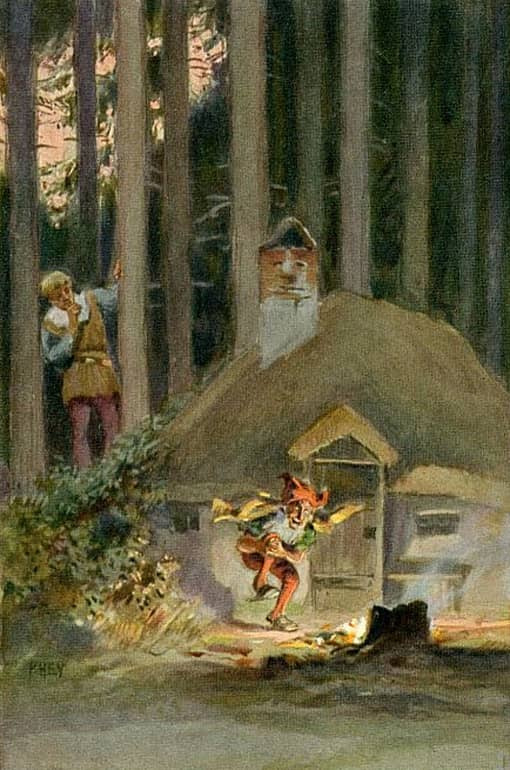
Rumpelstilzchen
Yes this story is the famous "Rumpelstilskin" (or Rumpelstiltskin? I never know how to write it in English). But why keep the German spelling? Because Rimasson-Fertin has some stuff to say about it: this name is the diminutive form of "Rumpelstilz", a term that Jacob Grimm defined in his "German Dictionary" as being synonymous with "poltergeist" (he noted a similarity between Poltergeist and Rumpelgeist, both designated a very loud spirit). While today "poltergeist" is mostly associated with ghosts, in a much broader way it designate a dwarf, a dead or a devil - or just any kind of phenomenon caused by witchcraft.
This story corresponds to the AaTh 500 "The name of the supernatural being". This fairytale has an interesting evolution history... Jacob Grimm had a version of it as early as 1808, named "Rumpenstünzchen", which was then slightly modified for the 1810 manuscript. This tale was actually the mix of two different versions - and one of these versions had a different ending. The queen didn't sent messengers searching for the dwarf's name, rather the king spotted the little man while returning from hunting on the third day. The Grimm also noted a variation where the initial situation was reversed: a young girl who had to spin hemp but could only manage to spin gold much to everybody's despair, and a small man appeared to promise her a wedding to a king's son in exchange for her firstborn child. It ended in such a way: the queen herself spotted the small man singing his name, jumping around a fire while riding a ladle like a horse. When she guessed his name, he flew out of the window and into the sky, riding the ladle like a witch's broom. We know that the episode of the spinning of the straw was only added by the Grimm in 1812 (it is not in the 1810 version), and that the final scene of the dwarf self-mutilating comes from a story of Lisette Wild and was added in 1819.
The first literary record of this story is a French fairytale published in 1705 and written by Mlle Marie-Jeanne L'Héritier de Villandon. It was "L'Histoire de Ricdin-Ricdon" (The Tale of Ricdin-Ricdon), published in her "La Tour ténébreuse et les jours lumineux" (The Shadowy tower and the luminous days). It had been translated in German by Johann Gottwert Müller in 1790, under the title "Straubfedern", "Ostrich feathers". As for the name "Rumpelstilzchen", it actually originates from Johann Fischart's Grman adaptation of the French "Gargantua", "Geschichtklitterung" (1584) - in it, Fischart lists various children game by name, and mentions a "Rumpele stilt oder der Poppart".
This fairytale type is very present in Western, Central and Northern Europe (British Isles and Ireland included), with also a few spottings in the Baltic countries, China and Japan. The name of the supernatural being always changes from one region or country to the next (in Swiss it is Hans-Öfeli, in Dutch Trillevip, in Swedish Titteliture, in Finnish Tuttirituli, in the Suffolk it is Tom Tit Tot, in Welsh Gnarwynathrot, in Irish it is Eve-Trot or Trit-a-Trot...). It is part of the enormous success of this tale-type: every country has to invent its own brand of nonsensical, un-guessable name. As for the rhymed song through which the dwarf betrays its name, it is found in England as "Nimmy nimmy not / My name is Tom Tit Tot", and in an Afro-American version of North Carolina "I'm so glad that she do not know / That my name is Tabutoe Tambutoe".
The brothers Grimm noted that in Germanic mythology it was typical for underground beings (aka dwarfs) to have names that are not usual among humankind, which is why, again according to them, the dwarf of this story would feel in perfect safety proposing the queen such a game. The rule according to which obtaining the name of a supernatural being means gaining a form of power over them is very common, and is even reused in another one of the Grimm stories: KHM 136, "Iron John". H. Rölleke did an analysis of the names the queen proposes at first: we have the three names of the Magi, aka the Three Wise Men, or King-Magi, which gives a Christian setting to the story, and could also serve as a metonymy for all the saint names found in the Christian calendar. As for "Heinz" and "Kunz", Rölleke sees in them the diminutives of the names of the medieval emperors Heinrich and Konrad, which used to be some of the most popular male names among German-speaking countries.
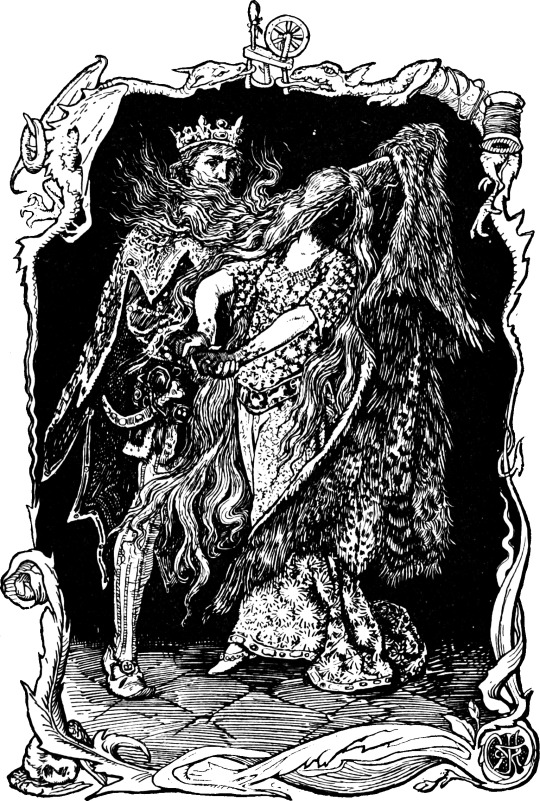
All-Kinds-of-Fur (Allerleirauh)
It corresponds to the AaTh 510B "The dresses of gold, silver and stars", also known as "Donkey Skin", after the famous Charles Perrault fairytales.
The story we read today was the one told to the Grimm by Dortchen Wild, but there was a variation of it told to the brothers by Jeannette Hassenpflug, "Princess Mouse-Skin", which was present in the 1812's edition of the volume (n°71) but was then moves to the annotations as a mere mention. The version of the story from the first draft (the 1810 manuscript) was called "Allerlei Rauch", "All Kinds of Smoke", and was heavily inspired by one of the tales present within the novel "Schilly" by Carl Nehrlich.
The line "God forbade a father from marrying his daughter. Nothing good can come from this sin which will cause the kingdom's decadence" was added in the 1819 edition, and references a tale of Albert Ludwig Grimm called "Brunnenhold und Brunnenstark". The brothers Grimm insisted even more on the condamnation of the sin of incest when rewriting the story for their "small collection" for kids, and also insisted heavily upon a political extension of such a decision, which would damage the state itself. It is actually an allussion to the failure of the Frankfort Parliament, which had been gathered in 1848 at the Paulskirche in an attempt to create a constitution for all of Germany - to which Jacob Grimm had taken part.
A variation of the story collected in Paderborn has the last coat made of all the furs of the kingdom, plus moss and various forest-related material. In this version, the heroine puts the cloak on top of her three beautiful dresses before fleeing, and she hides in an empty tree where she is discovered, not during a hunting party, but by woodsman that cut off the tree she was sleeping into, to bring wood to the king. All-Kinds-of-Fur works in the castle's kitchen but one day as she is preparing the soup, the king has her sit on his chair so she can delouse him (a motif also present in "The Devil with Three Golden Hair). As she does, the king glimpses the beautiful shining dress under the cloak's sleeve, and this is how he discovers the girl's true appearance. Another variation of the story yet, also collected in Paderborn, has the heroine pretending to be mute. One day the king hits her with a whip, it rips apart the coat, revealing the golden dress underneath.
Not all the German versions of the story include the incest motif. In Musaüs' take on the story, "Die Nymphe des Brunnens", "The Nymph of the Well", the heroine leaves her father's castle because it has been destroyed. Her godmother, an undine, gifts her a small magical box and when she leaves the ball she says "Night behind me and day before me / Might nobody see me!". As for the version of Hassenpflug, "Princess Mouse-Skin", it begins as the KHM 179, "The Goose-Girl at the Well": a king wants to know which of his three daughters love him the most, the first says she loves him more than the whole kingdom, the second more than pearls and precious stones, the third more than salt. The furious father has the last princess be sent into the woods to be killed, but the servant tasked with the execution spares her out of pity, and gives her, by her request, a coat made of mice skin. The rest of the story goes like within "All-Kinds-of-Fur", except for the final wedding, to which the father-king is invited. All the dishes served to him are without salt, and he ends up saying he prefers to die rather than continue eating without salt. The princess-daughter reveals herself and points out how he tried to had her killed for loving him more than salt. Her father begs her for forgiveness, and the tale ends with her accepting.
The motif of the incest can, however, be found back in a variation of the KHM 31 (The Girl Without Hands) that the Grimms collected, and where the father mutilates the daughter for refusing to marry him. The motif of the king trying to marry his own daughter has been attested in many, many European stories ever since the 12th century. As for the boots that are thrown in the heroine's face in the Grimm story, while in the final edition it has no follow-up, in the 1812 edition it was a recurring element forming a motif within the tale. Another German version of the story that preserved this structure that the Grimms erased is the story collected by Vernaleken, "Throw-Broom, Throw-Brush and Throw-Comb". In it the king throws out of anger at the face of the heroine (Adelaide) a broom, a brush and a comb. Every time she goes to the ball, she changes her pseudonym to fit which item hit her (one night she is "Throw-Broom", another she is "Throw-Brush", etc...). There are many, many variations of the story containing such a "name play".
Other famous examples of this variation, outside of Charles Perrault's Donkeyskin, include Straparola's "The maiden in the chest", Basile's "The She-Bear", Afanassiev's "Pig-Skin".
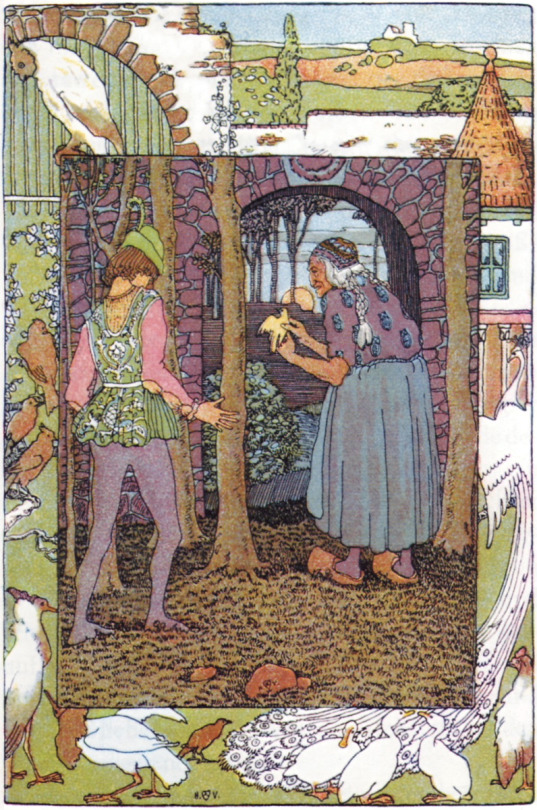
Jorinde and Joringel (Jorinde und Joringel)
It corresponds to the AaTH 405, named and created after this story, "Jorinde and Joringel".
The interesting thing with this story is that the brothers Grimm did not collect it from a direct source. Rather they lifted it, to the exact word, from the autobiography of Johann Heinrich Jung, "Jugend/Youth", published in 1779. The brothers deemed that the way Jung-Stilling had written the tale was the "perfect" way to tell the story, according to their definition of a fairytale. Though they did note the existence of a version of the story told in Schwalm - but which differs very little from the story of Jung-Stilling.
The brothers Grimm themselves noted a similarity between this story, and the KHM 123, "The Old Woman in the Wood". Rimasson-Fertin notes that the witch in this story is to be compared to the ones appearing in "Hansel and Gretel" and in "Little Brother and Little Sister". As for the name of the demon the witch invokes, "Zachiel", H. Rölleke identified it as a form of "Zachariel", a demon name coming from the very popular 17th century demonology grimoire "Clavicula Salomonis", "The Clavicles of Salomon".
#brothers grimm#grimm fairytales#brothers grimm fairytales#german fairytales#sleeping beauty#briar rose#snow-white#snow white#jorinde and joringel#all kinds of fur#the juniper tree#the devil with three golden hair#the three golden hair of the devil#the robber bridegroom#the maiden without hands#the girl without hands
47 notes
·
View notes
Text

'The Goose Girl at the Well' from Grimm's Fairytales by Rie Cramer, 1922
3K notes
·
View notes
Text
WAIT WAIT WAIT

YOU'RE TELLING ME
THE TITLE CARD FROM CINDERELLA (1950) EXPLICITLY SAYS IT'S BASED ON THE PERRAULT VERSION OF THE STORY???
WE COULD HAVE AVOIDED ALL THE SANCTIMONIOUS EDGELORDS SMARMING ABOUT HOW "well Disney toned it down; the One True Grimms' Original akschully has blood and no fairy and feet getting cut up, so there" IF THEY HAD JUST
BOTHERED TO PAY ATTENTION TO THE MOVIE AND THEN GOOGLE "PERRAULT CINDERELLA???"
excuse me I need to go scream into a pillow
(I'm not saying Ashenputtel isn't possibly older as a folktale than its 1812 publication date in the Grimms' book, but Perrault's version was published in the 1690s. so...)
#fairytales#folktales#cinderella#disney#charles perrault#the brothers grimm#and if you're obsessed with originality. the earliest recorded version of the story is like a paragraph long and completely bloodless#'there was a lovely courtesan. an eagle carried one of her sandals to Pharaoh. he used it to find her and married her. The End."#(Rhodopis if you want to look it up)
3K notes
·
View notes
Text
Here's how to write an authentic Grimm style fairytale, brought to you by a Certified German TM:
Forget everything Disney movies taught you, besides maybe Snowwhite, Cinderella, and Sleeping Beauty. But even those are on thin fucking ice. Also ignore modern fantasy literature conventions, especially Dungeons & Dragons type stuff.
Ideally only the protagonist or none of the characters ought to have names. And the names should either be really fucking ordinary, or some kind of epithet. Like, either that's a Franz or a Bramblesock, cause when Bramblesock was a child he lost a sock in a shrub of brambles. Everyone else is either the king, the grandma, or the carpenter.
The common types of protagonist: Regular working class guy who cons his way into a life of riches, poor downtrodden peasant who through hardworking kindness is granted salvation (usually via gaining riches), too pure too good for this world princess who can't catch a fucking break, too nasty too bratty for this world princess who gets taught a lesson in humility.
The characters are generally very one note and the only kind of character growth they can experience boils down to "maybe I shouldn't have been a dick, huh?"
The location is either as vague as possible or super fucking specific for no reason; either the story takes place literally nowhere or in the town of Buxtehude.
Animals and inanimate objects that can talk for no apparent reason and no one bats an eye at are always a great addition.
If you want to add any fantasy races, use giants (large, dumb brutes), dwarves (angry little guys who live in the wilderness and get really angry if you touch their beards), or gnomes (mischievous house spirits who might be helpful but watch out!), but never more than one of these. Fairies are rare and usually the "tall beautiful wise woman" type, not the small annoying pixie type. Dragons are very pointedly no-where to be found, those distinctly belong in sagas, which are their own distinct type of literature.
Weird moral of the story that either boils down to "be smarter than all the other fuckers", "good things happen to good people, bad things happen to bad people", or "don't upset the supernatural".
Random tidbits of gore that no one bats an eye at.
Witches eat children, if a mother gets more than single line dedicated to her she's evil, fathers are spineless and/or assholes who either die or come around in the end.
Ugly means evil, pretty means good. Except when it doesn't.
Optional: Repeated rhyming phrases and numbers. Seventh son of a seventh son kinda stuff. The numbers 3, 7, 12, and 13 in particular.
Ideally a 19th century scholar should be able to read some clumsy Germanic pagan wishful thinking into the story, no matter how big and obvious the Christian overtones are.
Optional: Start the story with "Once upon a time" and end it with "And if they didn't die, then they are still alive today."
#writing#fairy tales#fairytales#grimm's fairy tales#gebrüder grimm#brothers grimm#german stuff#writing advice
1K notes
·
View notes
Text
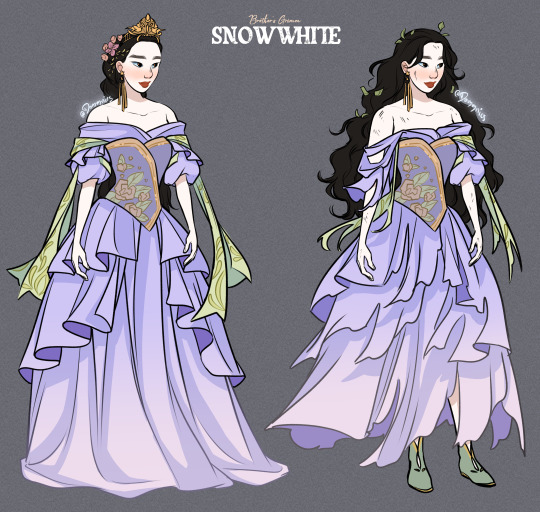
I love doing character designs for fairy tales and folktales, so here's my interpretation of Snow White for fun. I imagined her look on the left to be as she's taken by the huntsman into the woods, and then her look on the right after she's braved the woods and made it to the dwarfs' cottage.
--
Check out more of my work on other platforms!
My Instagram -- My Twitter
#fairy tales#snow white#brothers grimm#folktale#faerie tales#fairytale#fairytale art#fairy tale art#fairy tale illustration#snow white and the seven dwarfs#rt#dress#princess#character design#dress design
710 notes
·
View notes
Text
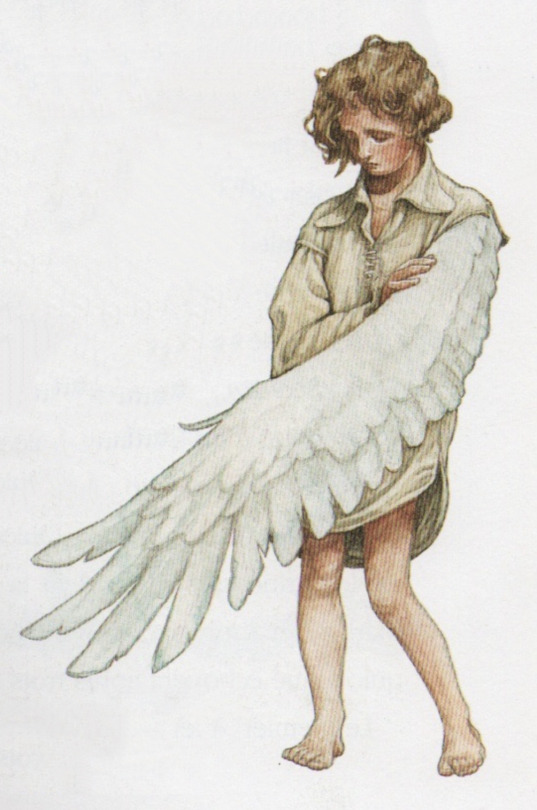
The Six Swans
Artist : Patrick James Lynch
#the six swans#les six cygnes#children's literature#fairy tale#children's books#fairy story#children's book#fairy tales#fairy#p. j. lynch#patrick james lynch#brothers grimm#the brothers grimm#les frères grimm#die sechs schwäne#german fairytales#german fairy tale#prince#wing#1993
969 notes
·
View notes
Note
I read your latest Grimm Legends bios. Keep up the good work. BTW got any more coming?
The Grimm Legends Pt.5


Scene : ‘Mother of the fairy prince’


#the grimm legends#grimm fairytales#grimm fairy tales#fairy tales#fairytale#fairy tale retelling#grimm brothers#thumbelina#the miller’s daughter#rumplestiltskin#fairy tale art#character artworks#character designs#digital characters#fantasy artwork#fantasy#the fairy prince#the dark fairy
144 notes
·
View notes
Text
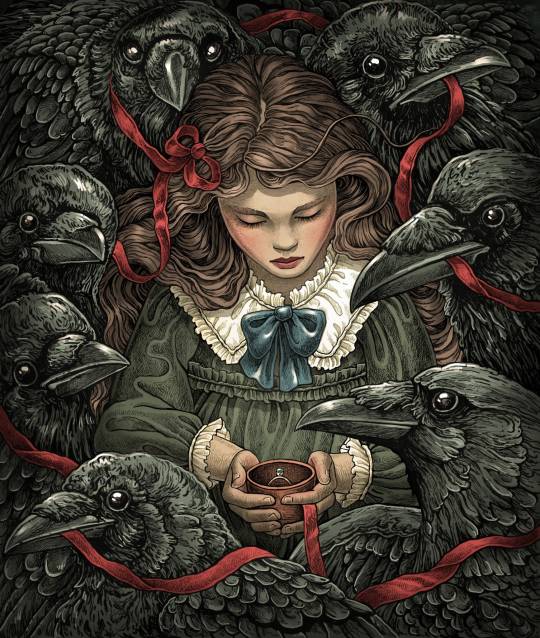
"The Seven Ravens" by the Brothers Grimm
418 notes
·
View notes
Text
King Magnifico Backstory : Part One
Ok! Here goes part one for my ideas for Magnifico’s backstory with the DisneyVerse! I based it on the fairytale “The Carnation/ The Pink” as recorded by the Brothers Grimm, the tale of a young man who’s every wish comes true…
Link to the fairytale I’ve based this on here

Once upon a time, a lonely, childless queen wished upon a star, and the star answered. The Fairy of the star said that for the Queen’s great kindness and pure heart, the child would be blessed with beauty, charm and that he would have the power to grant the wishes of his people, in order to bless the kingdom he would one day inherit.
(This is me justifying that “Mirrors love my face/got these genes from outer space” line xD)
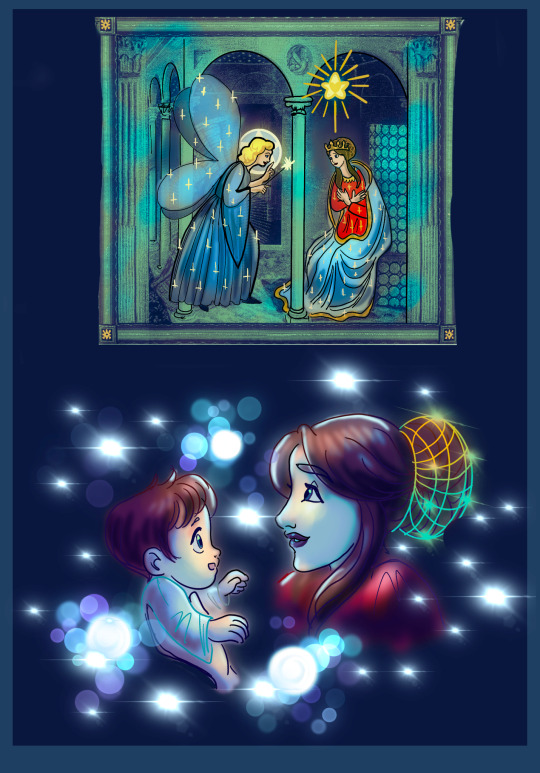
The queen was overjoyed with her son, and marveled at the magic he already displayed. She intended to keep his gift secret from the kingdom until he was older, in order to protect him, but it was too late. Word of his gift had leaked out, and one day the child was kidnapped.
He grew up under the watchful eye of his “parents”, granting them whatever they desired, wish after wish, day after day. Gowns and jewels, a manor house on the kingdom’s border, a fleet of fine hunting hounds to tear up the countryside. A covering of protection from any who might try and discover their whereabouts.
The child gave it all to them, for he felt the power of Love inside him when he used the gift that was meant to bless, and thought the love came from them.
They told him to never be selfish and wish for himself, though this was only to keep him from one day wishing in anyway that might undermine them. They lived in luxury and he in loneliness, for they of course allowed none to get to close to their prize lest another steal their good fortune.

Finally though, when the boy had become a youth, his loneliness became too great, and he wished deep in his heart for companionship. And the wish was granted. A beautiful young woman stood before him, shocked to be suddenly in a strange place before a strange man. But the youth was so comely, and spoke to her kindly and with assurances she would be safe with him, that soon she lost her fear. She still wished to return home, but the youth persuaded her to remain with him a while longer.
(He’s not evil yet obviously, but he’s always been a smooth guy and now he’s got a taste of having something he wants he’s loath to let it go. Which is understandable but can and will of course turn darker…)
For a time the youth hide the girl within the hallow of the pink rose bush in the center of the garden, and their loved bloomed with the roses they both found sanctuary in.

But eventually they were discovered by the youth’s “Father”. The boy confessed he had wished for a companion, and the man feigned acceptance. He asked the girl her name and origin, and she told him she was called Amaya, and that she hailed from the Kingdom of Córdoba. Upon further questioning, the man realized his stolen ‘son’s wish had pulled a woman to him from a completely different world.
Realizing the youth’s power would soon grow out of any control they could exact over him, the man and his wife determined to cut their losses and finally do away with him, lest their treachery be uncovered. Unbeknownst to them, the youth had overheard their plot, and began to plot his vengeance against the people he had believed to have been his parents.
Meanwhile, the leacherous man had taken a fancy to the girl, Amaya. He told her that if she aided him in getting rid of the youth he would aide her in returning back to her own world. Amaya had no interest in either the foul man nor in betraying the youth she had come to love, but she knew if she did not do as the man asked both she and her lover would be killed. So she took the heart of one of the man’s beloved hounds and brought it to him, claiming it to be the heart of the youth.
She rejected the man’s advances though, refusing him vehemently and reminding him their bargain was for him to help her to return home. Pretending to accept her rejection, the man waited until night to steal into her rooms within the manor, with a dagger drawn to plunge into the sleeping girl.
But he was met with the livid face of his erstwhile ‘son’ instead.
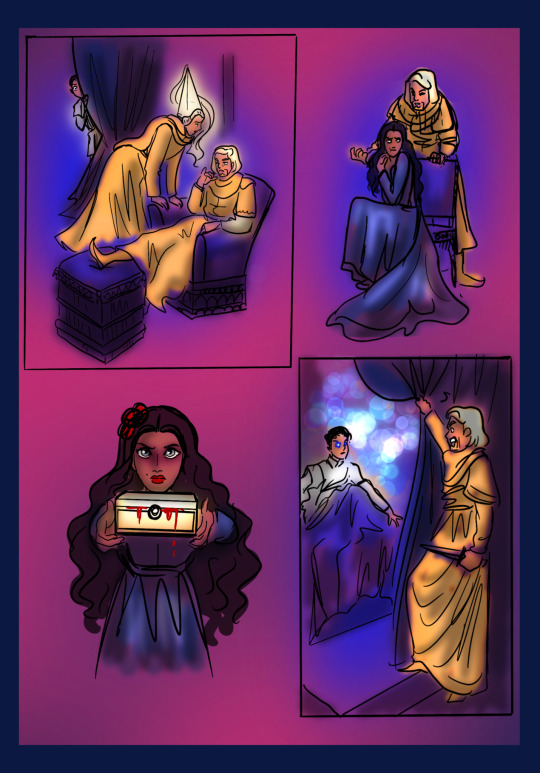
“So, ‘Father’, at last you show your true face. Your heart is a coal of envy, your wishes are cruel and selfish, you would take and kill with no more thought then your beloved hunting dogs do. So I wish that your outward self might reflect the beast within you!”
And with those words, the man’s bones shook and snapped, his hair darkened and spread, and soon enough a great beast spawns tearing around the manner, fire pouring from its insides as it burned all the ill gotten gains in the manor, and itself along with it.
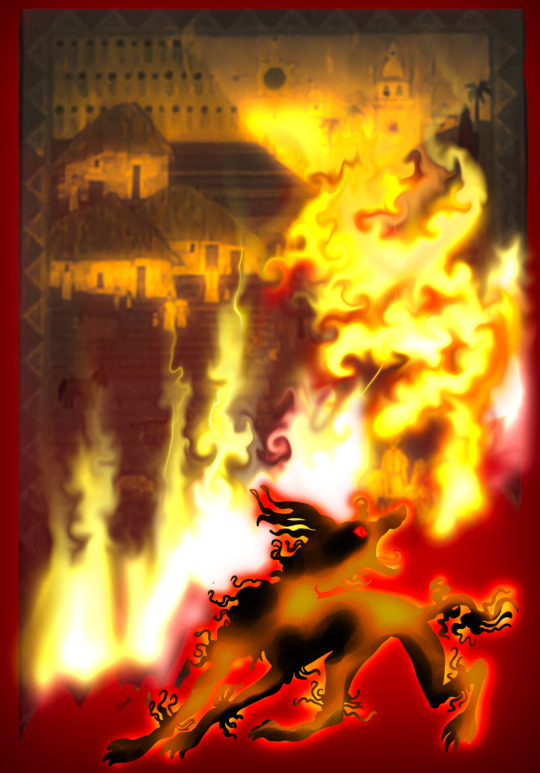
The youth attempted to return to his true mother, but tragedy has struck while he grew up ignorant of his heritage. The King, furious that the son he had waited so long for had been stolen, blamed the Queen for the tragedy, and locked her within a doorless tower. A bird came twice a day to bring her food, but her heart was broken, and she eventually wasted away. The people, who had loved the kind queen, rose up against the cruel king, and the kingdom was left broken and destroyed.
The youth had no wish to stay in this place, full of the memories of all the good that had been destroyed by two greedy thieves. The youth, a man now, innocence scorched from him, kept a part of the banner that once hung in the grand hall to remind himself the folly of granting the wishes of the undeserving
He was ready however to grant the wish of the one who had not betrayed him, his beloved Amaya. Her wish brought them a ship that would carry them across the waves of sea and space, and together they sailed off into another world…
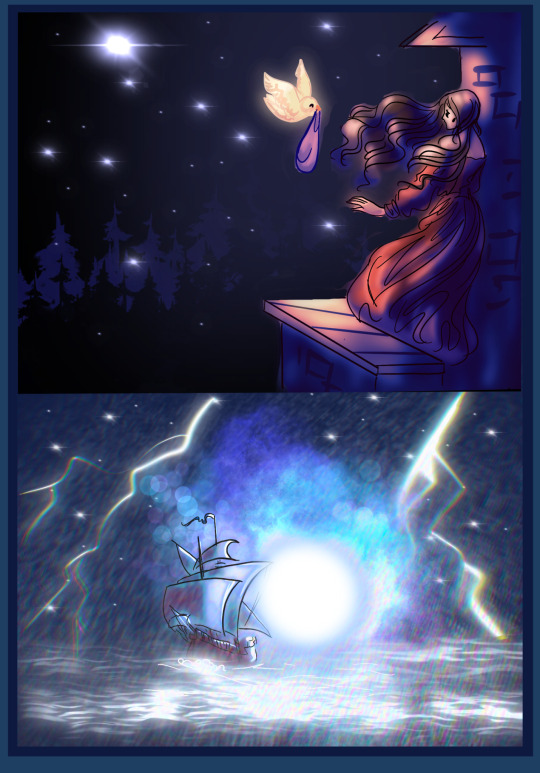
Edit: Part 2
#my art#disneyverse#disney#wish 2023#disney wish#king magnifico#queen amaya#amaya x magnifico#the pink fairytale#the carnation fairytale#the brothers grimm#villain backstory#disney villains#the blue fairy#who was very young when this all happened#and meant well but it didn’t go so well :/#cw body horror#cw death#wish movie#wishing star#disney fanart#disney fanfiction#wish fanart#wish fanfic
196 notes
·
View notes
Text
Disney leaving out the backstory for Rapunzels name is so funny to me, because in the fairytale it makes sense but in the movie she's just named after a salad.
For no reason other than mother gothel/ the king & queen are horrible at naming babies
#fairy tales#brothers grimm#Gebrüder Grimm#Die Märchen der Gebrüder Grimm#rapunzel#tangled#german fairytales#Funny
180 notes
·
View notes
Text
Books That Are Fairytale Retellings

The Sleeper and The Spindle by Neil Gaiman
A Court Of Thorns and Roses by Sarah J. Maal
Cinderella Is Dead by Kalynn Bayron
The Girl In Red by Christina Henry
Once Upon A Time: A Story Collection by Shannon Hale
Lost In The Never Woods by Aiden Thomas
The True Story Of Hansel and Gretel by Louise Murphy
Cinder by Marissa Meyer
The Big Over Easy by Jasper Fforde
The Mermaid by Christina Henry
House Of Salt and Sorrows by Erin A. Craig
Girls Made Of Snow And Glass by Melissa Bashardoust
The Storybook of Legends by Shannon Hale
The Wishing Spell by Chris Colfer
Forest Of A Thousand Lanterns by Julie C. Dao
Geekerella by Ashley Poston
The Fourth Bear by Jasper Fforde
Gingerbread by Helen Oyeyemi
To Kill A Kingdom by Alexandra Christo
Six Crimson Cranes by Elizabeth Lim
Once Upon A Broken Heart by Stephanie Garber
#fairytale#fairytale retelling#the brothers grimm#ever after high#books#book blog#booklr#readblr#book reccs#book recommendations#bookaddict#book list#fairytale book list#fairytale books#hans christian andersen#the little mermaid#little red riding hood#nursery crimes#beauty and the beast#hansel and gretel#cinderella#snow white#bookworm#books and reading
346 notes
·
View notes
Text
Given I have made two posts already about "Hansel and Gretel", or variations of the story, I'll make this fairytale the Grimm fairytale of this season. And since everybody knows Hansel and Gretel, and I already spoke somehow about it, I'll just leave below several notes, trivia and facts.
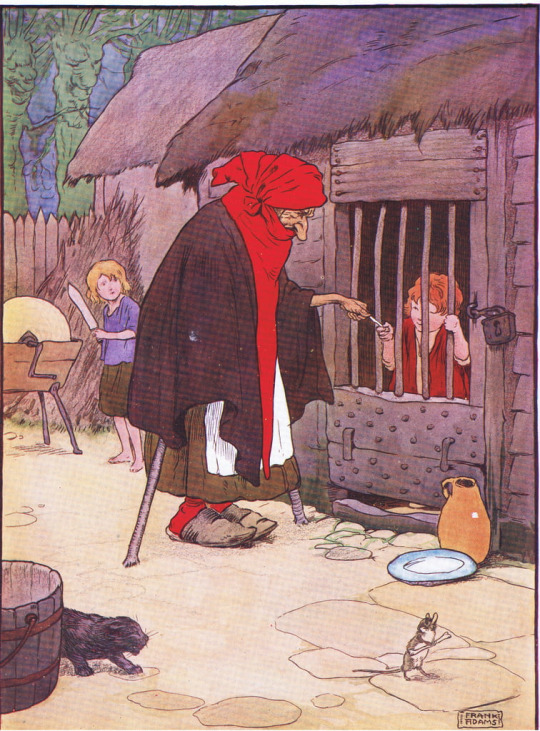
I have spoken before about the "original" version of the Brothers Grimm fairytale - aka the first edition of the text, and how it changed and evolved up to the story we know today. Many of these changes are well-known by the public - for example how the wicked stepmother was originally a wicked MOTHER (but the Grimm changed it because they had a mother-worship thing going on) ; or how the whole "duck scene" where the kids are helped crossing the river by birds was added later and not present in the original text. Some are less known, such as the fact that the "heavenly wind" rhyme was not part of the original text, or how Hansel's prison was originally not some sort of stable like in the final text but a tiny hicken coop.
In terms of "sibling stories" when we look at the great patches of historical fairytales and older literary works, you will find a lot of people pointing out to the Italian fairytale "Ninnillo and Nennella" by Basile - but I have to strongly disagree with this claim, because while Basile's fairytale does contain the motif of "boy/girl sblings abandoned several times in the woods, using various objects to find their way back, until it fails and they are lost forever", beyond that the fairytale has little to no relationship with Hansel and Gretel. A more direct ancestry and relationship has to be found in the French fairytale. More precisely in Perrault's Little Thumbling, Le Petit Poucet, which is also a story about children abandoned in the woods due to a lack of food, that found their way back several times before the birds eat the bread, and that end up in the house of a man-eater, an ogre trying to kill them. But we are still quite away from the German tale - and it is another French literary fairytale that forms the "missing link" in this chain. Madame d'Aulnoy's "Cunning Cinders" (Finette Cendron). This story doesn't involve children, but four young women - however it still follows the Hansel and Gretel formula very closely. Abandoned by their parents in the wilderness, manage to get back several times before it fails, end up trapped in the house of man-eaters, and the titular character defeats the ogre by pushing hm into a fiery oven... Of course, beyond that d'Aulnoy has a ton of additional content - such as the ogre having a wife that must be beheaded ; the lost girls being helped by a fairy godmother ; and the second part of the story being an alternate Cinderella.
But all in all it shows a point I made previously, and talked about in my ogre posts: the structure and type of the "Hansel and Gretel" story is originally an ogre tale. All older versions of the story involve ogres, not witches - but since the German do not have "ogres" in their folklore, the ogress was replaced by a witch. And despite this replacement, the witch of the story keeps several ogre traits - such as a motif of "the elderly devours youth", the idea of the witch having a poor eyesight but a keen sense of smell, or the entire "maternal perversion" motif. Which is my next point.
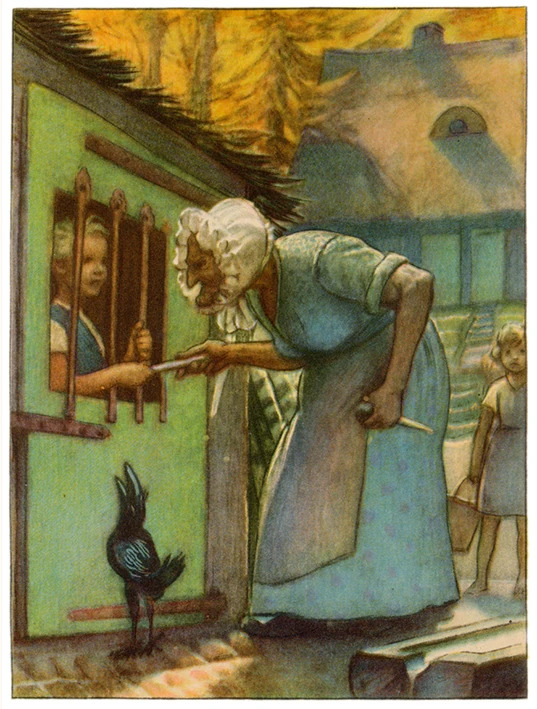
"Hansel and Gretel" is a familial tragedy, like many other fairytales. But the family of Hansel and Gretel is an actually extremely bizarre one. You can see, once you know your folklore and fairytale lore, that despite it being considered a "classic" and a "foundation", this tale is actually a fragmented and pieced-together story that leaves numerous gaps and is much more muddled and confused than its equivalents and predecessors. What I mean by that is that, when you look at the familial relationships in this story, you will discover several remnants of an older and more commonspread familial structure that was erased, and only leaves bizarre analogies in the new set of characters the tale offers.
To be clearer. We know that Hansel and Gretel are siblings, and that they have two parents - the father and the stepmother, formerly mother. The witch is an unrelated character acting as an outside element - or so it seems. The fairytale actually establishes a parallel and a connection between the wicked stepmother and the witch. They are parallel characters, two wicked women that want the death of children, but whereas one wants to throw the kids out of the house to leave them to starve or be devoured by beats, so she can have more food herself, the other imprisons the children in her house and overfeeds them to devour them later. A more direct link is established whenn the children return home, at the end of the tale, and discover that their step-mother is dead.
Some dark and edgy adaptations will have things such as the stepmother being killed by her husband, or killing herself, stuff like that - but by the tale alone, on just reading the words, and the first impression it leaves on a child, is that the stepmother mysteriously dies in unexplained ways right after the children burned the witch in her oven. The fact that the two wicked women end up deceased for the tale to end happily, the fact the stepmother's death is left unexplained while the witch's death is graphic and fully presented, the fact the stepmother's death is announced after the witch was killed... It all leaves the impression that the two were connected, and that by some sort of "parallel magic", killing the witch triggered the stepmother's death.
This is something many adaptations picked up upon, and you find versons where the witch and the mother look a lot alike, or are played by the same person, or are the same being. (One can compare it to Russian variations of the stories of Baba-Yaga, where wicked stepmothers sometimes send their nice stepdaughters a la Vasilisa the Fair, to the Yaga's house claiming the Yaga is their "sister"). All in all this continues the idea that the witch is a perverse take on the mother figure - nourishing and protecting children only to gulp them down into her stomach. Which, by the way, is the very symbolism and essence of ogres: fathers that kill, mothers that eat.

But while this is the most famous of the "perverse family connections" in the tale, there is another people tend to forget: the connection between Gretel and the witch. I talked heavily of the difference of treatment the witch has between Hansel and Gretel in a previous post ("Why was Hansel the meal of the witch?"). People have noted the strange discrepancy of Hansel being the one locked up and fattened up to be eaten, while Gretel became an abused slave. Many modern adaptations played on this element by having the witch planning on not eating Gretel, but making her an apprentice in witchcraft, an heir to her house, and treating her like a daughter/witch in training. After all, she does malnourish her, so she seems not keen on the idea of eating her at first...
But these modern adaptations actually picked up on something deeper and more fascinating. You see, the witch not locking up Gretel and treating her as her slave seems to be a leftover from older variants of the tale, because there is a widespread archetype in fairytales known as "the witch's daughter" or "the ogress' daughter". In many ogress or man-eating witches tales, the antagonist has a daughter that assists her in her chores. Sometimes the daughter will secretely help the protagonist escape and be an ally - but these are quite rare, and most of the time the daughter is the one the witch/ogress charges of killing-cooking the protagonist. Then the protagonist tricks the daughter, kills and cooks her instead of themselves, and serve her to their monstrous mother, who believes she is eating the protagonist, when in fact she devours her own daughter. It is a very typical structure in those tales, found from the Baba Yaga legends to the Kabyle tales of the teryel.
The witch's daughter archetype also exists in fairytales where the witch is not a man-eater, but rather an antagonist that imprisons people, or that imposes impossible tasks - and here, the daughter will be a more benevolent figure that will secretly help the protagonist escape the witch and/or overcome the trials and tasks the mother imposes. In fact, in several of those stories, the protagonist fights for the right to love and marry the witch's daughter.
All in all, the fact that Gretel is treated as a slave and assistant to the witch, that she is to help feeding and fattening her brother, etc, etc, implies that her character in the story of the Grimm is a leftover of the "ogress' daughter" or "witch's daughter" of older stories. As a result it makes even more sense for adaptations to have the witch treat Gretel as some sort of surrogate daughter, and it makes the whole family picture of the German story very messed up. The witch who tries to eat the children might be their mother/step-mother, and Gretel might be the witch's daughter.

Another motif that has been picked up by various adaptatons is the motif of birds. I remember long ago I stumbled upon a fascinating art series depicting the witch as a half-bird half-human creature - unfortunately the pictures are now lost in the vast pit of the Internet. More recently, another artist posted an image of Hansel in his cage, with the witch appearing a large, black bird above the cage, wearing a witch's hat.
All those art pieces reflected a true fact: "Hansel and Gretel" is a bird story. You have the birds that devour the bread crumbs, but also the pretty bird that leads the children to the witch's house, and the ducks that helps them cross the stream in the added ending of the Grimm. Some variations also have Hansel claim, when he keeps looking back at the house, that he is seeing a "pretty bird" instead of a "pretty cat" like in the Grimm's final text. As a result, some people did identify the birds that eat the breadcrumbs and/or the bird that leads the children to the house with the witch. The anime "Grimm's Fairy Tale Classics" notably depicted the pretty bird luring the children to the house as the witch's familiar.
A last note: The idea that the witch's house is made of tons of various candies and sweets was popularized by various modern adaptations and retellings of the story. In the Grimm tale, the house isn't made of candy. It isn't even made of gingerbread as so many people believe! While it is common for people to think of this tale as "the one with the gingerbread house", I don't know where that comes from. In the text of the Grimm, the house is merely made of bread, plain old bread, with sugar for the windows. There are however cakes that are said to cover the house, as ornaments. Maybe people in retellings decided to mix together the "cake"and the "bread" and decided to make it "gingerbread"? I don't know.
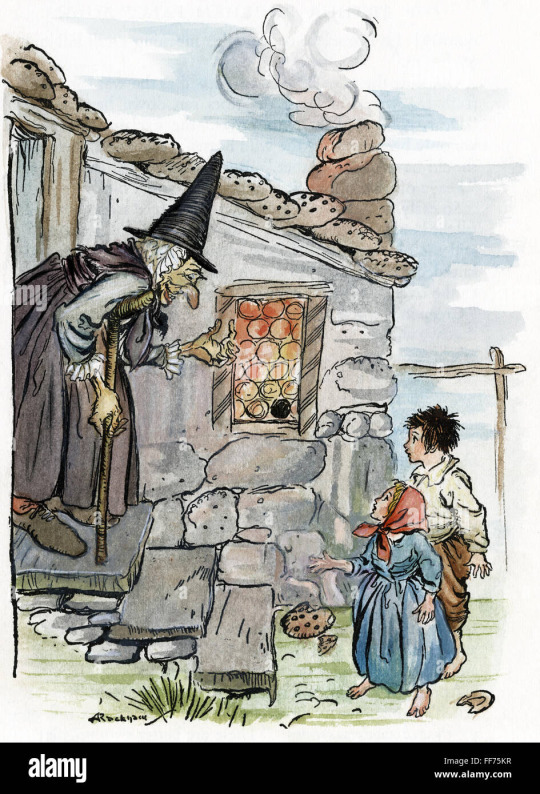
#hansel and gretel#fairytale analysis#gretel#fairytale witch#the gingerbread house witch#grimm fairytales#german fairytales#the brothers grimm#hansel#birds in fairytales
297 notes
·
View notes
Text

'The Seven Ravens' illustrated by Franz Stsssen, (1869 - 1949).
1K notes
·
View notes
Text




some more Chris/Snow White Concept looks for my AU inspired by the incredible 99!!
#disney#brothers grimm#fairytales#tangled#wild Kratts#fanart#chris kratt#Snow White#concept art#character art
22 notes
·
View notes
Text








fairytale illustrations by heinrich lefler
192 notes
·
View notes
Text
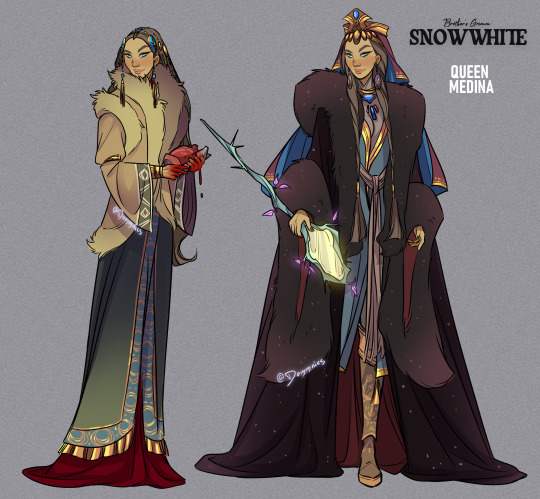
Here's my take on the wicked queen from the Brothers Grimm Snow White to accompany my Snow White design. It took forever to land on colours for the second outfit but I'm actually pretty happy with how these ended up. I gave her a hand mirror, just one out of many mirrors in her possession probably. I also gave her a name for my own headcanon of her.
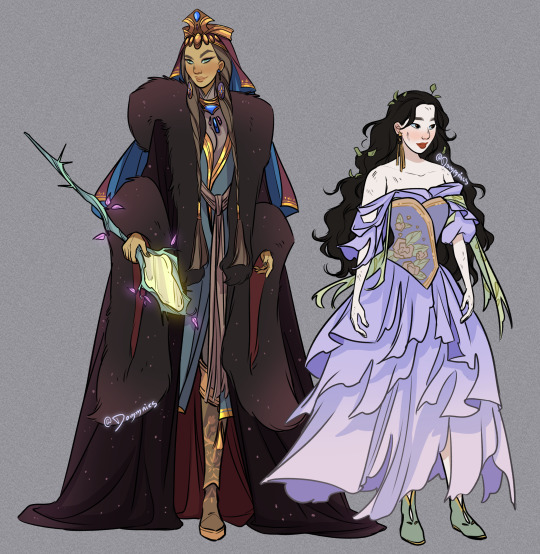
Here's the two together!
--
Check out more of my work on other platforms!
My Instagram -- My Twitter
#snow white#brothers grimm#fairy tales#fairytale#fairy tale#fairy tale art#fairy tale illustration#the brothers grimm#snow white and the seven dwarfs#princess#art#drawing#character design#redesign#dress#queen#evil queen#villains#wicked stepmother#grimms fairytales#literature#children's literature#fairy story#illustration#folklore#book art
449 notes
·
View notes